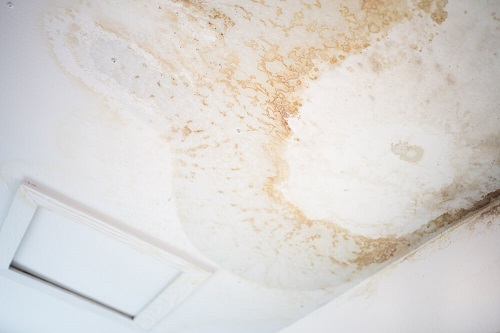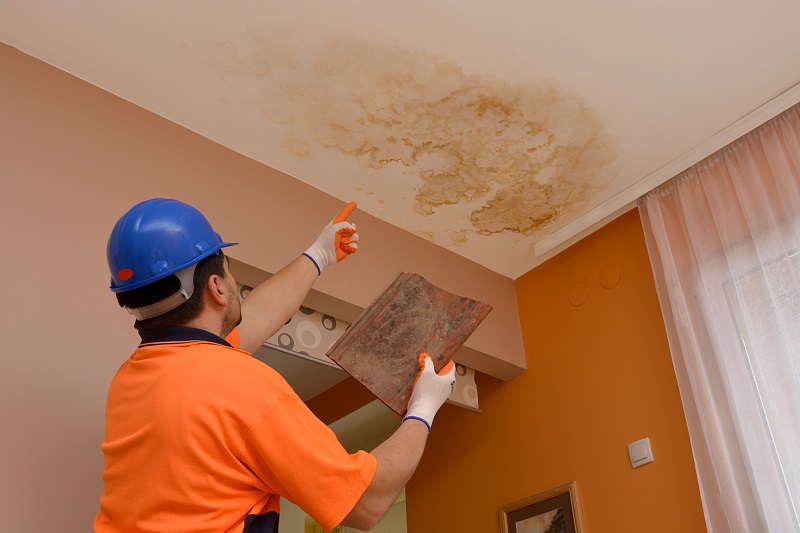Leaks in the ceiling can be caused by regular wear, storm damage, or other reasons. And if you don’t address the issue promptly, it might cause more structural damage. But getting hold of a professional roofer might be delayed for various reasons. In such cases, you should look for a temporary fix.
So, what is the temporary fix for leaking ceiling? A temporary fix for leaking ceiling refers to using materials that are easily available and don’t require professional expertise. So, you can do these fixes on your own. These DIY fixes are inexpensive, easy to complete, and will save you from further damage. This guide will enlighten you on some effective techniques to fix your leaked ceiling. Let’s begin.
Common Sources of Ceiling Leaks
Before you think of any measure to fix the leak, you should identify the source. Leaks can be caused by three common issues. Check them out.
1. Roof Damage
If the roofing material isn’t installed correctly, leaks can develop in the roof. And that will cause dampness in the ceiling. These leaks can also happen after a storm when the shingles or tiles are displaced.
2. Plumbing Issues
This is a common reason for ceiling leaks in multi-storied houses. Faulty caulks or rusty pipes upstairs can cause liquid to drip onto the ceiling. In extremely cold weather, water can turn into ice and expand the pipes. This can cause the pipes to burst and will result in leaks in the ceiling.
3. Faulty Appliances
If your home appliances don’t work properly, the dripping from these machines can also cause ceiling leaks.
Symptoms for Leaked Ceiling
Identifying a leaked ceiling can be tricky. You can look out for the following symptoms to be sure about the leaks.
● Musty Odor
If there are water poodles in the ceiling or the area is damp, mold and mildew will grow there. Over time, you will get a musty, unpleasant odor in the home.
● Dark Spots
Dirty water in the ceiling can cause the surface to develop dark spots. These are easier to notice if your ceiling has a light color. You should regularly check for any unusual color patterns on the ceiling.
● Presence of Insects
When the area is wet, insects will infest your ceiling and spread across the home. If crickets, mold mites, or termites suddenly grow in your home, it means there are leaks somewhere.
● Irregular Paint Texture
Even if the leaks don’t drip water onto the floor, the paint on the ceiling will have bubbles. It is a clear indication that the ceiling has leaks.
How to Fix a Leaking Ceiling in Easy Steps?
We have broken the process into simple steps so that you can follow along.
Step 1: Identify the Leak
The first step is to locate the leak. You can look for the symptoms stated above to locate the leak. Figure out what is directly on top of that spot to get an idea about the cause.
Step 2: Get Two Buckets
If water is dripping from the leaks, you must catch the dripping water to protect your floor and furniture. Take two medium buckets and place them directly under the leaked spot. If one bucket gets filled up, you can use another while draining the first bucket.
Step 3: Cover Furniture and Appliances
Dripping water may splash onto your furniture or electronic appliances. To prevent that, you need to cover the furniture and appliances nearby with polythene sheets or plastic tarps. It is also necessary to cover the floor with a tarp.
Step 4: Poke a Hole in the Ceiling
Collected water in the ceiling should be drained to prevent further damage. You should place a step ladder and reach the ceiling. Then, make a small hole in the ceiling using a screwdriver or a knife.
Remember, you shouldn’t stand directly below the leak because you can get wet. Make the hole in a way that the water drains into the bucket placed on the floor.
Step 5: Look for the Source
If you don’t block the source of the leak, water will again accumulate in the ceiling. So, you should check the roof, gutters, flashing, fixtures, etc., to identify the root cause. Once you have identified the source, we can use several methods for fixing it.
Temporary Fix for Leaking Ceiling: 4 Effective Methods
Damaged roofs can be temporarily fixed in different ways. Here is a quick overview of the techniques.
1. Use Polythene Sheets
If the leak on your roof isn’t that big, you can use polythene sheets to block the leak.
- The sheet should be a bit thicker so that it can prevent moisture from entering the attic.
- Take a sheet much larger than the hole so that no water can penetrate through the sides.
- Place the sheet onto the roof and secure it with roofing nails.
- You can also use bricks to weigh down the sheet.
2. Use Plastic Tarps
Tarps are much thicker than polythene sheets and can withstand stronger wind.
- If the leak or damage on the roof is too big, you need to place a large tarp on it.
- Make sure the tarp covers a large area and water can’t slide through the sides.
- Tarps must be secured with roofing nails. You can place heavy rocks or bricks onto the edges to hold the tarp in place.
- While placing the tarp, make sure it is flat against the roof. Otherwise, it will start flapping if the wind is strong.
3. Use Tar Paper or Roofing Cement
These elements are easily available in hardware stores. If the leak is small, you can use this method to temporarily fix the leak.
- Apply the roofing cement onto the leaks and patch the leak with a putty knife.
- You can apply two or three coats of roofing cement to seal the leak better.
4. Use Roofing Tapes
If fixing leaks on the roof is difficult for you, you can follow this method.
- Climb into the attic and find the leaked spot.
- Take roofing tapes and patch the leaks. You can use wider rolls of tape to fix larger leaks.
Remember, these methods aren’t permanent, so you should call a professional roofer as soon as possible.
Why Is Temporary Fix Important?
When your ceiling has leaks, you will need professional repair at some point down the lane. But waiting for that can cost you a fortune. Hence, patching the leaks as early as possible is crucial for the following reasons.
- If you don’t fix the leak temporarily, dripping water can damage your floors or furniture. And that will only increase your cost of repair.
- Collected liquids in the ceiling can damage the integrity of the whole ceiling.
- The damp condition of the ceiling is the perfect habitat for mold. So, the structural stability of the ceiling will be affected if you don’t fix the leak.
Conclusion
Leaked ceilings can be a nightmare, especially if you can’t get professional help right away. But if you know the temporary fix for leaking ceiling, you can manage the situation until the professionals arrive.
First of all, you need to locate the leak and drain the water. Then, you can find the source and use the above methods to patch the leak temporarily. Don’t ignore leaked ceilings for too long. Otherwise, they might cause serious damage to your house that will demand costly repair.

